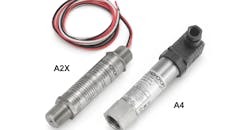Pressure Transmitters for Hazardous Duty
Ashcroft’s A2X (explosion-proof) and A4 (intrinsically safe) pressure transmitters accurately monitor pressure in hazardous locations. The explosion-proof version provides a compact UL and ATEX listed enclosure, while the intrinsically safe configuration is CSA and FM approved for both Class 1, Div.1 and Class 1, Div. 2 (non-incendive) applications. Both carry the CE mark. Pressure ranges from 0/5 through 0/10,000 psi are delivered in accuracies of ±0.5% and ±0.25% of full span, with an operating range between −40°/+125°C. Resulting measurement data are communicated through a choice of six different voltage or current outputs. At approximately one inch in diameter and less than five inches long, these transmitters are designed for remote pipeline installations where low power consumption is essential and “smart” communications protocol is not required.
Ashcroft, www.ashcroft.com

